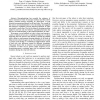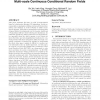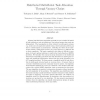20 search results - page 4 / 4 » Utile Distinctions for Relational Reinforcement Learning |
IROS
2007
IEEE
13 years 11 months ago
2007
IEEE
— Neurophysiology has revealed the existence of mirror neurons in brain of macaque monkeys and they shows similar activities during executing an observation of goal directed move...
IAT
2010
IEEE
13 years 2 months ago
2010
IEEE
When its human operator cannot continuously supervise (much less teleoperate) an agent, the agent should be able to recognize its limitations and ask for help when it risks making...
CIKM
2009
Springer
13 years 11 months ago
2009
Springer
This paper addresses the issue of social recommendation based on collaborative filtering (CF) algorithms. Social recommendation emphasizes utilizing various attributes informatio...
IJCAI
2003
13 years 6 months ago
2003
An interpretation system finds the likely mappings from portions of an image to real-world objects. An interpretation policy specifies when to apply which imaging operator, to whi...
ICRA
2003
IEEE
13 years 10 months ago
2003
IEEE
Existing task allocation algorithms generally do not consider the effects of task interaction, such as interference, but instead assume that tasks are independent. That assumptio...



